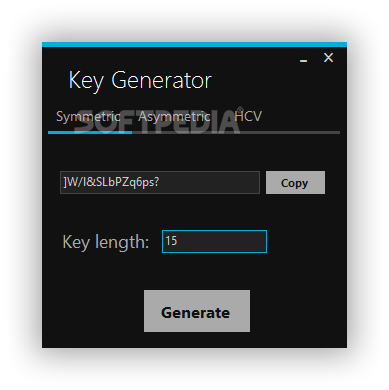Generate Aes 256 Key Linux
I had Java Code which generate key AES256 Bit key, have to implement same Code in .Net
3.How to Encrypt a file using AES generated key pair. 4.How to Decrypt a File using AES generated key pair. Let’s start performing this lab using an example lab. Then Generate a Key PAIR of AES+IV using Openssl. #openssl enc -nosalt -aes-256-cbc -k hello-aes -P Remember: in above command hello-aes is important and is like password. Ssh-keygen can create RSA keys for use by SSH protocol version 1 and DSA, ECDSA, Ed25519 or RSA keys for use by SSH protocol version 2. From the ssh manual: Public key authentication works as follows: The scheme is based on public-key cryptography, using cryptosystems where encryption and decryption are done using separate keys, and it is unfeasible to derive the decryption key from the encryption key.
Here is my sample java
Below is my .net Code
7z (when the password option is used) uses a 256bit AES encryption (with SHA256 key stretching). Install it (p7zip-full), right click on a file or directory you want to encrypt, and choose Compress,.7z and Other options /Password. For decryption, right click on the.7z file and choose Extract here. Dec 16, 2018 Windows Crypter/Decrypter Generator with AES 256 bits key - thelinuxchoice/hidden-cry. An AES-128 expects a key of 128 bit, 16 byte. To generate such a key, use OpenSSL as: openssl rand 16 myaes.key AES-256 expects a key of 256 bit, 32 byte. To generate such a key, use OpenSSL as: openssl rand 16 myaes.key AES-256 expects a key of 256 bit, 32 byte.
Above code generate key is “MnRpUVZmT3p5bG94R1RHYklMYU5Qdz09LDRZTUVQVlZWMHd0T2k3VGxEci9pejlBT3QvY215TFVNcFZ5ei93YnFuZk09”
I am getting key AES256 key from above code,which i had to convert it into bytes and pass at “skey” parameter in below function,but during execution of gcmb.Init(cipherOperation, ObjAeadParameters) i am getting error “invalid parameters passed to GCM”.

GCM Block Cipher Encryption
Tags: .net
OpenSSL is a powerful cryptography toolkit that can be used for encryption of files and messages.
If you want to use the same password for both encryption of plaintext and decryption of ciphertext, then you have to use a method that is known as symmetric-key algorithm.
From this article you’ll learn how to encrypt and decrypt files and messages with a password from the Linux command line, using OpenSSL.
HowTo: Encrypt a File
| Options | Description |
|---|---|
| openssl | OpenSSL command line tool |
| enc | Encoding with Ciphers |
| -aes-256-cbc | The encryption cipher to be used |
| -salt | Adds strength to the encryption |
| -in | Specifies the input file |
| -out | Specifies the output file. |
Interesting fact: 256bit AES is what the United States government uses to encrypt information at the Top Secret level.
Warning: The -salt option should ALWAYS be used if the key is being derived from a password.
Without the -salt option it is possible to perform efficient dictionary attacks on the password and to attack stream cipher encrypted data.

When the salt is being used the first eight bytes of the encrypted data are reserved for the salt: it is generated at random when encrypting a file and read from the encrypted file when it is decrypted.
HowTo: Decrypt a File
| Options | Description |
|---|---|
| -d | Decrypts data |
| -in | Specifies the data to decrypt |
| -out | Specifies the file to put the decrypted data in |
Base64 Encode & Decode
Base64 encoding is a standard method for converting 8-bit binary information into a limited subset of ASCII characters.It is needed for safe transport through e-mail systems, and other systems that are not 8-bit safe.
By default the encrypted file is in a binary format.
If you are going to send it by email, IRC, etc. you have to save encrypted file in Base64-encode.
Cool Tip: Want to keep safe your private data? Create a password protected ZIP file from the Linux command line. Really easy! Read more →
To encrypt file in Base64-encode, you should add -a option:
| Option | Description |
|---|---|
| -a | Tells OpenSSL that the encrypted data is in Base64-ensode |
Option -a should also be added while decryption:
Non Interactive Encrypt & Decrypt
Warning: Since the password is visible, this form should only be used where security is not important.
By default a user is prompted to enter the password.
If you are creating a BASH script, you may want to set the password in non interactive way, using -k option.
Cool Tip: Need to improve security of the Linux system? Encrypt DNS traffic and get the protection from DNS spoofing! Read more →
Public key cryptography was invented just for such cases.
Encrypt a file using a supplied password:
Generate Aes 256 Key Linux Version
Decrypt a file using a supplied password: